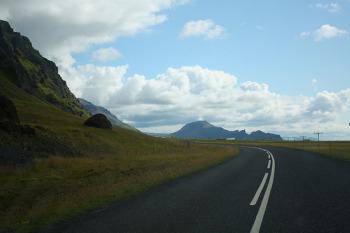Transportation
 For a small country, much of Iceland remained unexplored for quite a long time. In fact, the Ring Road, the 830-mile long main road that encircles the country, was only completed in 1974. There’s no train system in Iceland, but you still have several options for getting around within the country.
For a small country, much of Iceland remained unexplored for quite a long time. In fact, the Ring Road, the 830-mile long main road that encircles the country, was only completed in 1974. There’s no train system in Iceland, but you still have several options for getting around within the country.
Taxis in Reykjavik
There are several taxi companies that operate in Reykjavik, though the city is small enough that most tourists hardly have use for them except as a means of going off on day trips without having a rental car (and most drivers will gladly provide services for the day and act as a tour guide). Fares are standardized and all taxis are required to have a working meter. Tipping is not expected
Buses in Reykjavik
If you want to explore the further reaches of the city, you can do so by bus. Reykjavik’s bus system is clean and efficient. At the time of posting, rides were 280 ISK (a little over US$2) each way, but verify that before you get on the bus and make sure you have the exact fare (bus drivers won’t give change). You can check out timetables and route maps online.
Buses outside of Reykjavik
There are over two dozen different bus companies operating service throughout the country. Like most tourist services in Iceland, they are vastly cheaper in the winter than they are in the summer. Schedules vary with the season, and prices are based on the distance traveled. You can purchase tickets on the bus or at BSI bus terminals. Tickets are fairly expensive. For example, a ticket that allows you to travel the whole length of Route 1 (the Ring Road) will cost about 33,000 ISK.
Ferries
Ferry service connects mainland island to its many islands, like the Vestmann Islands, Grimsey, and Hrisey. In summer, book ahead as the ferries do sell out. And if you’re partial to sea-sickness definitely take some dramamine – the seas can be quite rough.
Hitchhiking
Iceland is a very safe country, and those who have hitchhiked here say more often than not, one of the first few cars to drive by will stop and pick you up. The problem is that in certain parts of the country, especially in off-season, you may be waiting several hours between passing cars.
Car Rental
The easiest way to get around Iceland outside of Reykjavik is rent a car. It’s not cheap though. Expect to pay about 10,000 ISK per day, plus the high cost of gas, about 200 ISK per liter. However, if you want to explore outside of Reykjavik and you don’t want to be stuck on an organized tour, a car rental can be well worth the cost. If you only the need the car for part of your journey, you can arrange (usually for just a few extra kronur) to drop it off in a different location that you picked it up.
Driving in Iceland is pretty straightforward. Icelanders drive on the right-hand side, and unlike many European countries where foreign drivers are warned of the locals’ crazy driving habits, here drivers are – for the most part – quite courteous. With the exception of a few hours during the weekend runtur when the streets of Reykjavik are packed with cars, you’ll find little traffic to speak of. Just don’t get stuck behind a caravan of slow moving buses on the Ring Road in high season.
The Ring Road is very well maintained throughout most of Iceland, as are the roads around Reykjavik, but if you plan to venture farther off this beaten path, you’ll need a car with four-wheel drive. Every car rental agency hands out a very scary-looking brochure warning tourists all about the dangers of driving in Iceland; it’s not to be taken lightly. Intense winds, loose gravel, flash floods, blind curves, whiteouts, and narrow bridges are among the hazards you’ll face. This video on driving in Iceland shows you some of the dangers and how to deal with them.
During winter, the roads in the interior of the island, and in many other places, are completely closed. You can view the current conditions on roads all over the country thanks to a network of webcams set up around the Ring Road.
Flying
Flying is often the best way to travel long distances in Iceland, especially if your time-table is condensed. Pilots in Iceland boast that they are some of the best in world because they are skilled at flying in extreme winds and heavy snow. Flights within the country tend to be short and inexpensive, especially when compared with the cost of car rental or bus tickets. One way fares can be as low as 5,000 ISK. Air Iceland offers flights from Reykjavik to 13 destination in Iceland and Greenland.
Photo by dreamo